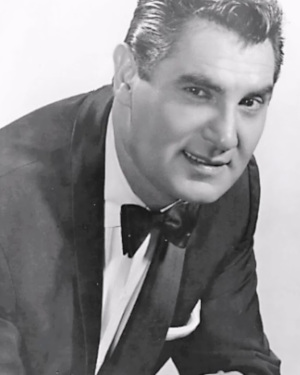Ralph Young

-
Birth Name
Ralph Israel -
Born
July 1, 1918
New York, New York -
Died
August 22, 2008 (age 90)
Palm Springs, California -
Orchestras
Les Brown
Shep Fields
Tommy Reynolds
Singer Ralph Young was one of the few big band vocalists who found greater fame in the post-band era than he did during its heyday. Young began his career on the bandstand in 1940 and broke out as a solo artist after the war. He is best remembered today as one-half of the entertainment duo Sandler and Young, popular during the 1960s and 1970s.
A New York native and the youngest son of Russian Yiddish-speaking immigrants, Young worked as a messenger at Warner Bros. in the mid-1930s while he pursued a career in singing. He sang in local clubs and restaurants before landing a job with Tommy Reynolds in September 1940, where he remained until joining Les Brown in summer 1941. He left Brown in May 1942 and signed with Shep Fields in June, replacing Ken Curtis, who had just been drafted.[1] His stay with Fields was short as he too fell victim to the draft in August.
During the war, Young served in the army, singing with the unceremoniously named AATC Band No. 2 at Fort Bliss, Texas. After his discharge, he returned to show business, but little opportunity came his way until 1949 when he signed with the Happiness label, owned by bandleader Louis Prima. Happiness dubbed him their “top swoon boy,” teaming him with Keely Smith for a recording. Young also recorded on RCA Victor that year, singing for Irving Fields’ Trio. He caught the ear of London Records, who distributed American recordings in the United Kingdom, and they signed him late in 1949. In 1950, he began to record on Decca, where he was often teamed with other artists, including Sy Oliver and comedian Joey Faye. He remained with Decca until 1956, when he moved to Epic. Young’s recordings where generally well-received, but he never had a major hit.
In 1958, Young landed a role in the short-lived Broadway production Whoop-Up, which ran for a month-and-a-half. He also sang on the cast album for MGM Records. He performed on a few television programs in the 1950s, and in 1960 his voice appeared on the soundtrack of the nudist film Hideout in the Sun, the first of his three contributions to the genre. Nude on the Moon followed in 1961 and Blaze Starr Goes Nudist in 1962, the latter in which he also performed on-screen under the pseudonym Russ Martine.
Young finally managed to latch onto success after he met Belgian singer Tony Sandler[2] in Milan, Italy, during 1963, where the two men were rehearsing for a French revue being imported by the Dunes in Las Vegas. They got along well, and in 1965 they teamed up, becoming an instant hit. The duo were featured on a plethora of television programs during the late 1960s and early 1970s and had their own summer replacement series, filmed in London, in 1969 and 1970. They recorded for Capitol Records.
Sandler and Young continued performing together until 1983, when Young, twenty years older than Sandler, retired from show business. Young’s wife, Muriel, whom he had married in October 1941, died in 1984, and he remarried two years later. Ralph Young passed away in 2008 at the age of 90.
Notes
Sources
- “Ralph Young.” IMDb. Accessed 6 Jan. 2022.
- “Mary Ann McCall With Reynolds.” Down Beat 1 Oct. 1940: 2.
- “Les Brown Hold over Gets New Vocalist.” Down Beat 15 Aug. 1941: 18.
- “Tied Notes.” Down Beat 1 Oct. 1941: 10.
- “Ralph Young to Leave Les Brown.” Down Beat 1 Jun. 1942: 13.
- “Shep Field's [sic] Singer to Head Army Band.” Down Beat 1 Jul. 1942: 15.
- “Shep Fields Has Many Changes.” Down Beat 15 Sep. 1942: 1.
- “He Dood It!” Down Beat 1 Feb. 1943: 10.
- “Things to Come.” Down Beat 9 Sep. 1949: 7.
- “Prima And Phyllis Swoon; You?” Down Beat 21 Oct. 1949: 13.
- “Norvas' Upstars Sign With London.” Down Beat 30 Dec. 1949: 1.
- “Things to Come.” Down Beat 17 Nov. 1950: 11.
- “Popular Records: Five-Star Discs.” Down Beat 7 Sep. 1955: 17.
- “Strictly Ad Lib.” Down Beat 3 Oct. 1956: 8.
- “TV Mailbag.” Greenfield Recorder [Greenfield, Indiana] 23 Aug. 1969: TV6.
- Prial, Frank. “Ralph Young, Sandler & Young Singer, Is Dead at 90.” The New York Times 26 Aug. 2008, https://www.nytimes.com/2008/08/26/arts/music/26young.html, Acessed 6 Jan. 2022.
- “New York, New York City, World War II Draft Registration Cards, 1940-1947,” FamilySearch (https://www.familysearch.org/ark:/61903/1:1:W849-RJ3Z : Sat Mar 09 17:22:52 UTC 2024), Entry for Ralph Israel and Tommy Reynolds Orchestra, 16 Oct 1940.
- “United States Census, 1920,” FamilySearch (https://www.familysearch.org/ark:/61903/1:1:MJPM-QBK : Sat Mar 09 02:31:02 UTC 2024), Entry for Nathan Israel and Tillie Israel, 1920.
- “United States Census, 1930,” FamilySearch (https://www.familysearch.org/ark:/61903/1:1:X453-NDR : Sat Mar 09 18:46:29 UTC 2024), Entry for Nathan Israel and Tillie Israel, 1930.
- “Texas Birth Index, 1903-1997,” database, FamilySearch (https://familysearch.org/ark:/61903/1:1:VD66-M6Z : 1 January 2015), Ralph Young in entry for Neil Philip Young, 10 May 1944; from “Texas Birth Index, 1903-1997,” database and images, Ancestry (http://www.ancestry.com : 2005); citing Texas Department of State Health Services.
- “United States Census, 1950,” FamilySearch (https://www.familysearch.org/ark:/61903/1:1:6XYQ-DYTS : Tue Mar 19 20:23:10 UTC 2024), Entry for Ralph Young and Muriel Young, 10 April 1950.
- “United States Social Security Death Index,” database, FamilySearch (https://familysearch.org/ark:/61903/1:1:JGG5-ZW1 : 12 January 2021), Ralph Young, 22 Aug 2008; citing U.S. Social Security Administration, Death Master File, database (Alexandria, Virginia: National Technical Information Service, ongoing).